|
9: Find Native Plants In Your Area
The USDA has excellent online guidance for finding plants native to your state and even your county. The following tutorial includes screen shots to help you use their website to identify suitable plants for your project. You may want to visit a nearby native plant nursery to see what’s available. If no native plant nursery is nearby, you’ll have to look up what is available in your area with this database.
Always avoid invasive plants. Some of these, such as perwinkle (vinca minor or major), English ivy, and Yellowflag iris may be sold at your local nursery. For more information, visit the California Invasive Plant Council’s website: http://www.cal-ipc.org/ip/management/plant_profiles/.
Tutorial
Tutorial Directions &
Related Information |
What To Look For OR
What You’ll See |
- 1: Go online to the USDA PLANTS Database at: plants.usda.gov
|
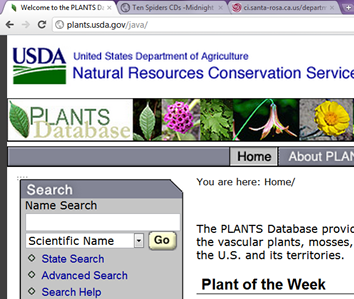
|
- 2: In the upper left hand corner click on “Advanced Search”.
(For better viewing, the left navigation bar has been cropped from the rest of the screen shots.)
|
- 3: We’re going to pick and choose a few different items on the “Advanced Search and Download” web page. Not all search options need attention. For any of these scroll menus, you may have to click outside the box (in white space) to get your choice to “stick”.
- Start by scrolling down under
“1. Distribution” to “County Distribution” and choose your county. In this example, we chose California: Trinity.
|
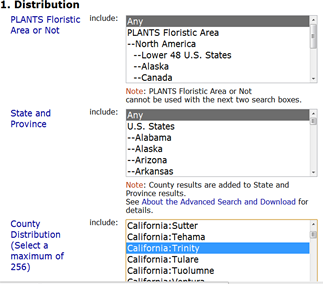
|
- 4: Scroll down under “2. Taxonomy” to “National Common Name” and click the checkbox to the right that says “Display”
|

|
- 5: Scroll down under “3. Ecology” to “Duration” and choose “Perennial”
|

|
- 6: Go to the next item under “3. Ecology” to “Native Status” and choose “-- L48 Native”
|
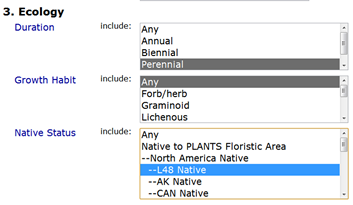
|
- 7: Scroll down (or up) to the “Display Results” button and click on it.
|

|
- 8: A list (partially shown here) of all plants native to Trinity County in California with their common names is generated:
|
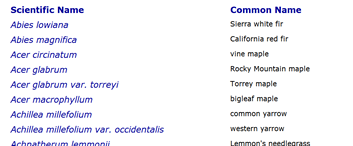
|
- 9: To narrow the search to certain types of plants, like shrubs and trees, click on the “Back” button or back arrow of your internet browser (see next step & figure).
- Selections that might be appropriate to plant in a rain garden or your landscape area are:
- Forb/herb (flowering plants that aren’t grasses, sedges, & rushes)
|
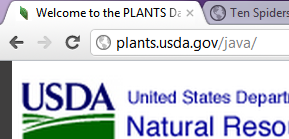
|
- Graminoid (grasses, sedges, & rushes)
- Shrub
- Subshrub
- Tree
- Vine
|
- 10: Scroll down to “3. Ecology” and “Growth Habit”.
For this example, choose “Forb/herb”. (To choose more than one selection at a time in any of these lists, hold down the “Ctrl” button on your computer while scrolling and clicking. Once you’re done selecting, you can double check your selections by letting go of the Ctrl button and scrolling around to see if more than one selection is highlighted. )
|
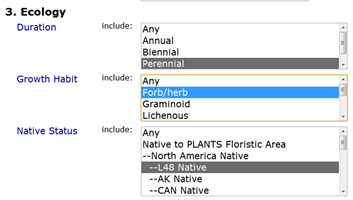
|
- 11: Your previous choices should still be selected. Scroll down to “Review Selections or Sort Report” button in the middle or bottom of the page and click this to see what criteria you’ve entered so far.
|

|
- 12: After you click, you’ll see all your criteria listed.
|
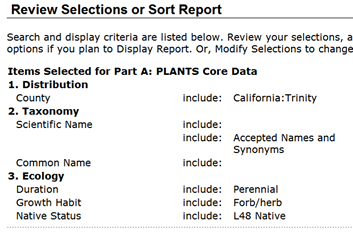
|
- 13: Now click the “Display Results” button at the bottom of this page.
|

|
- 14: This list (partially shown) is narrowed to native, perennial flowering plants in Trinity County in California.
|

|
- 15: To narrow your search to find plants appropriate for different moisture zones, scroll to “4. Legal Status” and look for “National Wetland Indicator Status” as follows: Click the back button on your browser twice to the “Advanced Search and Download” page. Scroll to “4. Legal Status” and under “National Wetland Indicator Status”. Holding down the Ctrl button throughout, choose “-- FACW (Facultative Wetland)”, then scroll down and click on “-- FAC+ (Facultative +)”.
- The different moisture zones of a rain garden (base, slope, top) can be correlated to National Wetland Indicator Status as
shown in this rain garden diagram:
|


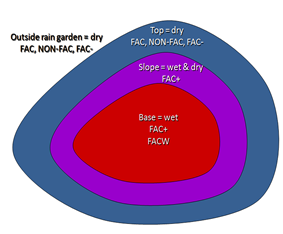
|
- 16: Let’s review our choices by clicking on the “Review Selections or Sort Report” button.
|

|
- 17: Click on the “Display Results” button at the bottom of this page.
|

|
- 18: You’ll see all the flowering, native, and perennial plants native to Trinity County, CA that are appropriate for the wettest zones of a rain garden.
|

|
Links to Plants Native to Your County
We’ve done some of the sorting for you. The links below will give you a list of perennial plants native to your county and will indicate whether they are a forb/herb (flowering plants that aren’t grasses, sedges, and rushes), graminoids (grasses, sedges, & rushes), tree, shrub, subshrub, or vine. Wetland status is indicated in the list, but has not been narrowed to any particular status (i.e. FAC+, FAC, etc). Even if you are looking in your county, it is important to keep in mind your elevation, aspect (how much shade the area will get), and other factors unique to your home’s location that will affect your plants and trees.
Del Norte: http://tinyurl.com/6vqk42f
Humboldt: http://tinyurl.com/c46nbuz
Mendocino: http://tinyurl.com/ctu4l62
Siskiyou: http://tinyurl.com/77vjcj9
Trinity: http://tinyurl.com/6pz3tym
Bibliography
Tutorial created from USDA PLANTS Database website: http://plants.usda.gov/
Photo Credits
All figures except rain garden in step 15 are screenshots of the USDA PLANTS Database website: http://plants.usda.gov/.
Rain garden figure in step 15 based on graphic from Candace Stoughton.
Download/View the 5C Program Stormwater Management Handbook:
Download by Chapters:
For more information, contact us
©2012. Five Counties Salmonid Conservation Program and Green Girl Land Development Solutions. This publication may be photocopied or reprinted in its entirety or in portions for noncommercial purposes. This publication is available in an accessible format on the 5C web site at http://www.5counties.org/docs.htm. If future documents are based on this document, credit should be given with the following wording: “Portions of this document are adapted from “09FindNativePlants.doc”, http://www.greengirlpdx.com/JOBS/5CSCP/09FindNativePlants.doc ©2012, Five Counties Salmonid Conservation Program and Green Girl Land Development Solutions. No risk or liability by either of these organizations shall be assumed for information offered in this document.”
Back to Land Use Planning page
Back to Programs Page
|
